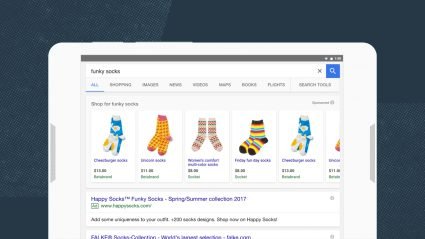When it comes to e-commerce advertising, affiliate marketing isn’t usually the first thing that comes to mind. Most digital marketers will rattle off search, social, content, SEO, programmatic, and a few other channels before getting to affiliate, if at all.
But when it comes to efficient, performance-based online advertising, especially with the rapid acceleration of the trend toward online shopping, affiliate marketing should be a staple of your marketing strategy.
I can sense you typing “What is affiliate marketing” into Google right now so I’ll save you the search and convoluted industry-speak.
What is affiliate marketing?
Affiliate marketing has three steps:
- An affiliate promotes your brand on their website/social media page via an affiliate link.
- A customer clicks on that link and places an order within a certain time frame (i.e. cookie window).
- You pay the affiliate a commission for that purchase.
It’s a win-win: your brand gets the sale, the affiliate gets a cut. The concept is simple, but obviously there are a lot of cogs and wheels turning behind the scenes to establish a solid program and build the relationships needed to ensure your brand is being promoted consistently.
How to start an affiliate marketing program
Even if you aren’t familiar with affiliate marketing, you’ve almost certainly encountered affiliates before while online shopping. So let’s start with some key terminology:
- Affiliate: also called a Partner or Publisher, they span categories from coupon sites to loyalty/cashback sites to major news sites to influencers and more. Almost any website can be an affiliate. RetailMeNot? Affiliate. Honey? Affiliate. Rakuten Rewards (formerly known as Ebates)? Affiliate. Business Insider? Affiliate. Your favorite mommy blogger and YouTuber? Very likely an affiliate. You’ve probably noticed disclosures in gift guides and product reviews that read something like, “When you buy something using the links in this article, we may earn a small commission.” The links they’re referring to are affiliate links.
- Affiliate link: a trackable URL that is unique to each affiliate in your program and directs to your brand’s website. That landing page can be customized (i.e. homepage or PDP). The URL can be placed into simple text copy or embedded into creative assets like banners or GIFs. Once it’s clicked on, a cookie is stored in the shopper’s browser and the clock starts tickin’.
- Cookie window: not as delicious as it sounds, this is known by several names including referral period, tracking gap, and cookie duration. This is the timeframe your company allows for a purchase to occur (after an affiliate link has been clicked on) in order for the affiliate to earn commission on that sale. It can be as short as 10 minutes or as long as three months, depending on your vertical.
- Commission: earnings by the Publisher after a customer purchases from your site through the affiliate link. You can choose a flat dollar amount or percentage to be paid out per sale or per lead. There’s even the flexibility to specify payouts for individual Partners and/or by affiliate category. You can also set up a performance bonus structure to incentivize each affiliate to drive higher volume (e.g. additional 3% commission on revenue over $20k for the month or a flat $2,000 bonus if they generate over $100k in sales in one month).
Before all of that can happen, however, you will need to find the affiliate network whose capabilities align with your brand’s needs.
Choosing the right affiliate network
Some networks cost less and others offer more robust features. I recommend checking out as many options as you can at the beginning of your venture into the affiliate space because migrating platforms down the line can be a headache, both financially and tech-wise.
Networks can charge a percentage of Publishers’ commissions (e.g. 2% of what you pay an affiliate) each month, a monthly flat fee, or a larger sum upfront for a year’s use of their platform. Consider your budget, reporting must-haves, the interface ease-of-use, range of affiliates that are already present on each network, and performing an audit of your competitors’ affiliate programs.
- Affiliate network: a platform that tracks affiliate activity (i.e. click traffic, conversions, revenue, spend, etc.) and serves as the central hub for managing your program. This is where you can pull reporting, refresh your promotions and creative assets, vet affiliates into your program, update your commission structure, all that jazz. Search Engine Marketing has Google Ads and Bing Ads to manage campaigns, Affiliate Marketing has affiliate networks to do the same. Since I don’t play favorites, here are a few major networks listed in alphabetical order: AvantLink, AWIN, CJ, Impact Radius, Pepperjam, Rakuten Advertising, and ShareASale.
Once you decide on a network, your Affiliate Manager will work with your dev team and the network to integrate the affiliate pixel with your website. Once that is placed successfully, your AM can set up your default commission terms, guidelines for affiliate approvals, affiliate-facing branding… Essentially, the foundation of your program.
- Affiliate Manager: the person responsible for the management of your affiliate program. This person can be an in-house resource or from an agency. They have the expertise to analyze data on both a big-picture and granular level, must come up with and execute strategies to propel your program, and have a vast network of Partner connections.
- Pixel: lines of code that go on your checkout page. It only fires if the order was catalyzed by a click on an affiliate link. It typically records the affiliate that referred the sale, date/time of sale, and the order amount, but you can add parameters like promo codes, SKUs, and item count if you’d like to track that too. Customer-identifiable information is not recorded. The pixel then sends that order information to the network, where the AM can monitor aggregate- and Partner-level performance. It is imperative that the pixel remains on your checkout page unperturbed and that it reflects accurate order information since that is how revenue (and thus commission) is attributed to each affiliate.
After an affiliate program is launched, most of an Affiliate Manager’s tasks can be boiled down to two core purposes: recruitment and optimization. A healthy affiliate program has a variety of Publishers that span the consumer purchase funnel. Major networks allow affiliates to look up the brands that run on their platform so they can apply to the programs that interest them. This means some Partners will find your program on their own, but your AM will do the heavy lifting in terms of Publisher outreach to recruit quality affiliates to sign up.
Vetting publishers for your affiliate marketing program
A fine-tuned vetting process is important to prevent diluting your brand value, which can occur if your brand has a presence on seedy-looking websites and/or an oversaturation on coupon sites. Stringent approval criteria add security to your program as well, since low-quality Publishers may incur fraudulent traffic and sales.
Your AM will sift through Publisher applications and approve/decline them. Some factors your AM may take into account when researching prospective Partners and reviewing applications include the site’s credibility, audience demographics, relevancy to your brand, traffic, aesthetics and layout, and whether your competitors have a presence there.
Approved Partners need to be trusted, legitimate sites since their role in the customer journey is to promote your brand.
Diversifying the types of Publishers in your program also decreases the likelihood of becoming too reliant on a few Partners. If only one, two, or a small handful of Partners comprise the majority of your program’s performance, imagine the hit to your KPIs if they happened to have a bad month. Ideally, you want as many of the Partners in your program to be active (i.e. driving clicks at minimum, preferably with conversions and revenue).
So: you have Partners in your program. Now what? I’ll take “Optimization” for $200, Alex. I think of optimization as an umbrella concept that encompasses most tasks that occur post-approval.
Optimizing and scaling your affiliate marketing program
Brand recognition is a key pillar in building and sustaining momentum in the affiliate space. If you are a smaller brand, it may take longer for your program to scale. If you are a larger brand, your program may take off fast but results may plateau just as quickly. Big or small, the goal is to get your Partners to promote your brand on an ongoing basis and subsequently, generate conversions consistently. What can you provide to make it easy for them to do so?
One way is to keep regular, timely communication of new product launches, sales, updated creative assets, and site updates. You can do this with newsletters. This is crucial so that your Partners have the most up-to-date information on your brand to share with their respective audiences. Next is by booking placements or creating exclusive codes. Extending TM+ bidding rights is another option.
- Newsletter: email communication to the Partners in your program. Every affiliate network has an in-site tool to compose messages. While your AM can use their work email address to communicate with individual or small groups of Partners, most will use network newsletters to send mass emails.
- Placement: additional exposure that an affiliate gives your brand, typically in exchange for increased commission and/or a flat fee upfront and/or an exclusive code. Placements can come in the form of premium promotion locations on the affiliate website (e.g. on their homepage), a dedicated article or blog post, inclusion in an email send to their newsletter subscribers (not to be confused with the previous affiliate term), and many other opportunities. The flat fee can vary and is dependent on the placement and the Partner. Your AM will negotiate the cost on your behalf, usually leveraging a higher commission percentage in lieu of a large flat fee. If the Partner is in agreement, they will send an IO (insertion order) to be signed. Once both parties have signed, the AM will schedule payment for the placement in the network.
- Exclusive code: a promo code where its vanity text is unique to a Partner. You may want to grant these to select affiliates if they are offering a great placement in return or if you simply want to entice a top-tier Partner to promote your brand. The offer itself does not have to be exclusive. For example, Company X decides to create exclusive codes for four affiliates: GOMEZ10, MORTICIA10, WEDNESDAY10, PUGSLEY10. Each code is unique but they all offer the same 10% off sitewide.
- TM+ bidding: a paid search campaign run by an affiliate. They pay for it entirely out of pocket while you continue to only pay per sale (or per lead, whichever your program is based on) that they generate. The only terms/phrases they are allowed to bid on are “[your brand name] + coupon” and the like. I would recommend granting no more than three affiliates TM+ bidding rights at any given time. In rare instances, affiliates may TM+ bid without your permission. You’ll want to nip that in the bud as soon as possible since they may be cannibalizing sales from approved TM+ Partners and driving up bids, or they may just be a low-quality affiliate taking advantage of your brand. Note that these rights can be used as a bargaining tool in securing placements. For example, I give permission to Affiliate Z to TM+ bid on Company X for two months in exchange for a homepage placement on their website and a product review article. Affiliate Z bids on phrases like “Company X discount”, “Company X promo code”, “Company X coupon code” in Google Ads and Bing Ads. A shopper clicks on the ad (Affiliate Z pays the search engine). The ads drive to Company X’s storepage on Affiliate Z’s website. The customer sees there’s a promo for free shipping and clicks on that link, which is an affiliate link. The shopper makes a purchase within the cookie window (Company X pays Affiliate Z).
Reporting affiliate marketing performance
Reporting is essential to guiding the decisions made for optimizing your affiliate program. Every network offers various reports. Common types include performance by day, performance by Partner, performance by SKU, performance by promo code, and so on. Timeframes can be adjusted to match the periods you want to look at. You want to see how many orders were driven during your Labor Day Sale versus the week prior? You can do that. You want to see how much revenue a specific Partner has driven month-to-date? That too.
Your AM is charged with drawing actionable insights from reporting and will keep track of your program and Partners’ performance daily in order to guide strategy.
For example, if a placement was booked on a certain day but revenue did not increase, your AM may avoid booking that particular placement again and go with a different option in the future.
Most networks’ reporting will show net metrics; some can display both gross and net. Because it is performance-based and billing is done in arrears, affiliate is one of very few marketing channels that can accommodate returns.
Your AM can process reversals at the end of each month so that commissions aren’t paid out on fraudulent, canceled, and/or returned orders. Commissions and network fees are typically automatically withdrawn from your account balance, so ensure that your program is properly funded. Your AM can keep an eye on your account balance but the actual deposits are usually made by someone on the finance team.
- Reversals: also known as voids or returns. Networks do have a locking period on transactions and once it is closed, orders/commissions cannot be edited. Your AM will know the deadline to process returns each month.
An affiliate program works in tandem with other marketing channels very effectively to create a cohesive brand story. Like most things in life, they work better together.
Integrating your affiliate marketing program with other marketing channels
Collaborative efforts in affiliate, SEO, paid search, paid social, and other channels all increase brand awareness. This ripple effect also affects Publishers as shoppers do their research on your brand and/or products before checking out.
Your program can also be integrated more directly with channels like SEO and social. For example, you can share top keywords and best-selling products with an affiliate that has agreed to write an article featuring your brand. After it goes live, your brand’s Facebook page can promote that article (“Check out this post that Affiliate Z wrote about us!”), which is a good-faith gesture to the Partner. We are endeavoring to have more people read that article—which hopefully bolsters your brand’s allure—then click on the affiliate link(s) to head to your site and make a purchase.
Although this is a behemoth of a post, this overview barely scratches the surface of affiliate marketing strategies and potential.
Affiliate marketing can be an immensely lucrative channel since investment is lower-risk and based on revenue share, but you (or your AM) will need to put in the work.
There is not a lot of automation in this space, no switches that you can turn on and off to add affiliates to the program or boost a promotion.
An affiliate program is extremely high-touch and requires nimbleness and constant communication. I like to say that “Partners” is used interchangeably with “affiliates” because this channel is very much relationship-based. As such, it is an incredibly dynamic beast. Fostering great relationships with Publishers is the cornerstone upon which all succeeding processes lie.
Because it is such an involved and hands-on marketing channel, you will need a capable and personable affiliate manager to represent your brand. There is no secret sauce to affiliate marketing but if there were, I think this article would be one of the ingredients (totally unbiased opinion). Jokes aside, an affiliate program truly has the potential to be a powerhouse in any company’s marketing portfolio, especially when it’s in the right hands.







Responses